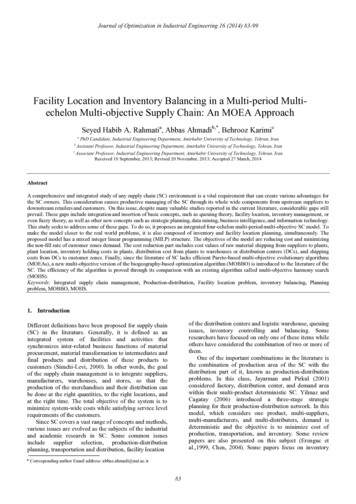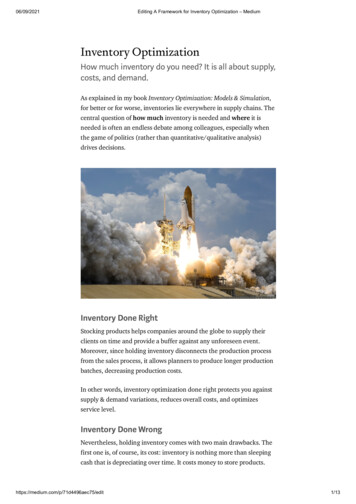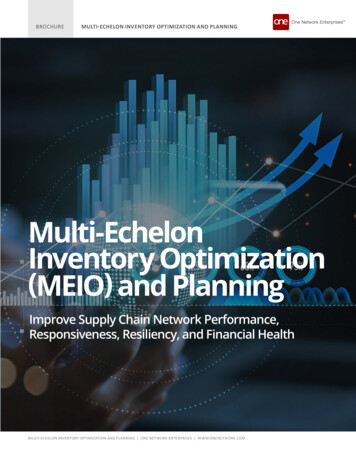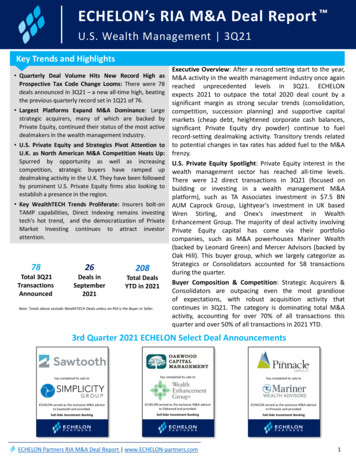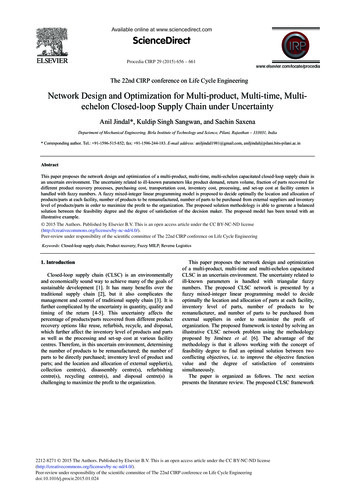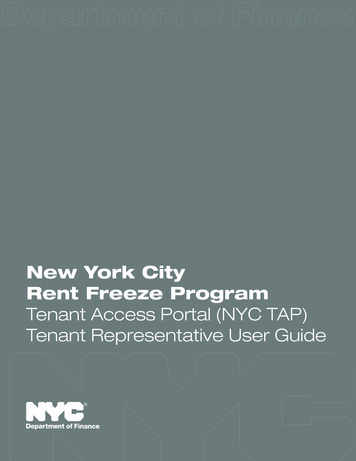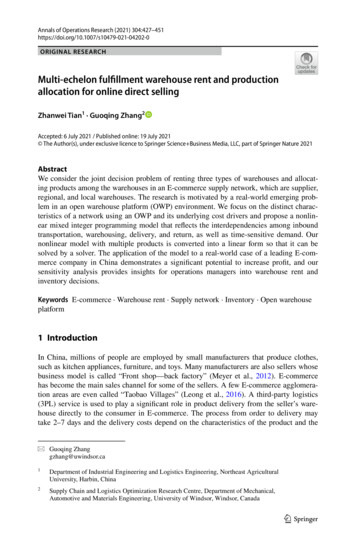
Transcription
Annals of Operations Research (2021) 202-0ORIGINAL RESEARCHMulti‑echelon fulfillment warehouse rent and productionallocation for online direct sellingZhanwei Tian1 · Guoqing Zhang2Accepted: 6 July 2021 / Published online: 19 July 2021 The Author(s), under exclusive licence to Springer Science Business Media, LLC, part of Springer Nature 2021AbstractWe consider the joint decision problem of renting three types of warehouses and allocating products among the warehouses in an E-commerce supply network, which are supplier,regional, and local warehouses. The research is motivated by a real-world emerging problem in an open warehouse platform (OWP) environment. We focus on the distinct characteristics of a network using an OWP and its underlying cost drivers and propose a nonlinear mixed integer programming model that reflects the interdependencies among inboundtransportation, warehousing, delivery, and return, as well as time-sensitive demand. Ournonlinear model with multiple products is converted into a linear form so that it can besolved by a solver. The application of the model to a real-world case of a leading E-commerce company in China demonstrates a significant potential to increase profit, and oursensitivity analysis provides insights for operations managers into warehouse rent andinventory decisions.Keywords E-commerce · Warehouse rent · Supply network · Inventory · Open warehouseplatform1 IntroductionIn China, millions of people are employed by small manufacturers that produce clothes,such as kitchen appliances, furniture, and toys. Many manufacturers are also sellers whosebusiness model is called “Front shop—back factory” (Meyer et al., 2012). E-commercehas become the main sales channel for some of the sellers. A few E-commerce agglomeration areas are even called “Taobao Villages” (Leong et al., 2016). A third-party logistics(3PL) service is used to play a significant role in product delivery from the seller’s warehouse directly to the consumer in E-commerce. The process from order to delivery maytake 2–7 days and the delivery costs depend on the characteristics of the product and the* Guoqing Zhanggzhang@uwindsor.ca1Department of Industrial Engineering and Logistics Engineering, Northeast AgriculturalUniversity, Harbin, China2Supply Chain and Logistics Optimization Research Centre, Department of Mechanical,Automotive and Materials Engineering, University of Windsor, Windsor, Canada13Vol.:(0123456789)
428Annals of Operations Research (2021) 304:427–451distance between the seller and consumer (Tan et al., 2014). Direct online selling channelsare increasing for many manufactures and farms worldwide. This growth in e-commercehas been given a major boost by the COVID-19 pandemic.Despite the exponential growth that E-commerce has enjoyed and its potential for further rapid gains, the logistics sector develops at a slower pace and becomes a restrictionon e-commerce sales, especially during festive periods of high demand (Zhou, 2013).Although E-commerce and logistics have been heavily studied during the past decades,there are still few empirical studies that explore how logistics services and infrastructureimpact the business-to-consumer (B2C) markets (Tan et al., 2014).Warehouses play a critical role in fulfilling online customer orders by coordinating supply and demand throughout the supply chain. Renting a warehouse is more cost-effectivethan buying and gives more flexibility for many e-commerce businesses. Based on theobservation of CBRE, demand for smaller warehouses is soaring due to e-commerce andonline shopping drivers up rent for the warehouse in U.S. (Smith 2019).Since 2012, several large-scale open warehouse platforms (OWP) have been built toimprove E-commerce logistics in China. Figure 1 shows the OWP built by JD.com Inc(Chan et al., 2018). Sellers can rent storage capacity and purchase warehouse services fromOWP. Their products are stored at decentralized warehouses across the country until thoseproducts are picked according to orders and shipped to the consumer through a 3PL service. OWP has become a big business for several companies in China. They encouragesellers to rent warehouses in their OWP by offering the following competitive advantages: Improving delivery efficiency and consumer service Decreasing the cost of transportation, warehousing, and delivery Locating products close to many consumers through hundreds of warehouses scatteredacross the country Flexible renting options and professional warehousing service Other value-added services, such as, kitting services, labeling, repackaging, and returnsprocessing.Fig. 1 OWP built by JD.com Inc.in China13
Annals of Operations Research (2021) 304:427–451429Renting warehouses from OWP is an attractive choice for small sellers, who have nocapital to build distributed warehouses by themselves. However, a wide range of factors,such as diversity between products, consumer service requirements and demand variability, influence the most appropriate supply chain segmentation (SCS) (Lovell et al.2005). Therefore, sellers are eager to know the answer to the following issues: Should they rent space capacity from an OWP? If they do, how much space capacity should we rent? How do they decide the inventory at each warehouse, i.e., allocate their multipleproducts among the rented warehouses, considering different types of warehouses?The purpose of this research is to answer these issues. With the COVID-19 pandemic,the shift from traditional shopping to online buying is accelerating. This researchfocuses on the allocation of inventory among online order fulfillment warehouses togain insights for small or medium-sized sellers who engage in direct online selling.A large body of literature is devoted to the problem of traditional warehouse rental,instead of E-commerce. Lim et al. (2018) analyze warehouse rental market segmentation and provide a systematic framework to empirically derive warehouse rental submarkets. Holzapfel et al. (2018) study product allocation to different types of distributioncenters (DC) in retail distribution networks, where the retail company operates the DC.Yu (2019) develop an inventory model for deteriorating items in a two-echelon twowarehouse system: an enterprise’s own warehouse and a rented warehouse. Recently,attention has turned to third-party logistics provider (Domingues et al., 2015; Ren et al.,2020) or third-party shipping internet platform (Chen et al., 2019). However, none ofthose research focuses on warehouse rental under e-commerce.The research is to aid optimal decisions on the selection and rent of online fulfillmentwarehouses and on the multi-echelon inventory optimization problem. The problem isdifferent from existing research in the following three aspects: First, the sellers need todecide which warehouse will be selected and determine the size of rented space from anOWP. Second, the time sensitivity of demand is considered, which affects both warehouse rent and product allocation. Third, the decisions about space rental, inventorylevels, and transshipment to meet time-sensitive demand are considered simultaneously.To the best of our knowledge, it is the first research to study multi-echelon online fulfillment warehouse rent and inventory decisions under the E-commerce supply network.Our main contributions include the following:(1) We present a mixed-integer model for multi-type warehouse selection and multi-echelon inventory decisions under E-commerce. To our knowledge, it is the first suchmodel that accounts for online fulfilling warehouse rent and inventory decisions in anE-commerce supply network structure. Our model is nonlinear but can be convertedinto a linear one, which can be solved by a Mixed Integer Linear Programming (MILP)solver.(2) We analyze the applicability of our model using a real-world case of a leading E-commerce supply network in China and conduct a comprehensive sensitivity analysis.(3) We reach several meaningful managerial insights that are helpful for sellers to makedecisions on the issues listed above.13
430Annals of Operations Research (2021) 304:427–451The remainder of this paper is organized as follows. Section 2 presents an overview ofthe related literature. The problem background is discussed in Sect. 3. After formulatingthe mathematical optimization model in Sect. 4, we derive managerial insights by applying sensitivity analyses in Sect. 5. Finally, we conclude the study and give an outlook onopportunities for future research in Sect. 6.2 Related literatureThere are three streams of literature related to this study. First, we analyze related researchon online order fulfillment warehouse rental and related platforms. Second, we draw parallels with research on multi-echelon inventory management that a provide methodologicalcontext for our research problem. Third, we describe a few publications that are highly relevant to our product allocation decision problem.Warehouses are critical to online selling. However, a large body of literature is devotedto the problem of traditional warehouse rental (Lim et al., 2018; Yu, 2019). A two-warehouse system usually includes an enterprise’s own warehouse and a rented warehouse,which is one of the strategies to resolve the issue of warehouse space shortage (Gupta et al.,2020; Tiwari et al., 2017; Yu, 2019). In recent years for offline companies persuaded to bee-commerce, choosing a suitable and competitive warehousing provider has become moreimportant than ever. Wu (2016) explores the features of "overseas warehouse" based onthe analysis of the development of cross-border e-commerce and make recommendationsfor building an "overseas warehouse" platform. On the other hand, warehousing providers also face great pressure to meet their customers’ needs: a high level of time and placevalue for their deliveries, lower prices, the last mile problem (Domingues et al., 2015). Gu(2017) set up an assessment system for 3rd warehousing provider under the environment ofe-commerce, and find a strategy to promote service quality.The challenge of selecting warehouses and the quantities of products to stock has somesimilarities with the multi-echelon inventory problem (Clark & Scarf, 1960). A multi-echelon inventory system is commonly observed in many business environments. After decadesof research, many articles are focusing on the system in the field of operations management, including two notable reviews (Agrawal & Smith, 2015; Gümüs & Güneri, 2007).While more than two echelons are sometimes used in practice, most retailers, includingAmazon.com, now prefer a two-echelon system (Agrawal & Smith, 2015). Such supplychain structures are similar to that of our case, but the difference is that the product allocation decisions are made by different actors with different business considerations.The fundamental decision problem to be solved in multi-echelon inventory systems isthe appropriate division of inventory among warehouses. Mathematical models are presented to make unique inventory decisions in different scenarios, for example, bricks-andmortar retail (Axsäter & Zhang, 1999; Grahl et al., 2016; Guo & Li, 2014), online sales(Min et al., 2006), combined brick-and-mortar and online retailer (Bretthaueret al., 2010),and manufacturing (Pan & Nagi, 2013; Shankar et al., 2018). However, in these studies,product allocation among warehouses is treated as a given, and it is generally assumed thatthese decisions are taken at an upper planning level (Holzapfel et al., 2018). Additionally,although our case is in an e-commerce scenario, the structure of supply network is dualchannel. To our knowledge, few models focus on our particular scenario, and very fewconsider delivery time sensitivity issues.13
Annals of Operations Research (2021) 304:427–451431Holzapfel et al. (2018) consider the problem of assigning multi SKUs to warehousesbelonging to different types available to retail companies, which is highly related to ourproblem. They propose a MIP model that accounts for interdependencies between inboundtransportation, outbound transportation, and in-store logistics, for capital tied up in inventories, and for differences in picking costs between the warehouses, which extends thedependences considered by Lovell et al. (2005). The warehouse network is similar to ours,but the problem is not under E-commerce and the company operates a warehouse, insteadof renting. Furthermore, we consider time- sensitive demand, which is important in theE-commerce environment. Guerriero et al. (2013) address the product allocation problemin a multi-layer warehouse with compatibility constraints, and present a linear model toreduce delivery times, inventories and total logistics costs, while also raising service levels.Similar studies include Tsiakis et al., Scott et al. (Fay & Xie, 2014; Tsiakis & Papageorgiou, 2008).Our literature review indicates the following findings. First, the problems of warehouseselection and allocating products to specific warehouses are essential planning tasks andan optimal allocation will lower costs. Second, although E-commerce dominates warehouse lease business, very few quantitative models are available for studying warehouserent under E-commerce. To the best of our knowledge, there is no directly related quantitative decision model available in the literature that considers the scenario that we focus on.Therefore, we develop a model that accounts for various interdependencies among factorsin the multiple-product allocation problem in rented online fulfillment warehouses and conduct sensitivity analyses to obtain strategic managerial insights. Our research is intended tosupport operations managers in making decisions on product allocation to specific warehouses of different types, and in finding the answer to the questions raised in Sect. 1.3 Problem background and OWPIn this section, we provide the OWP background and describe the decision problem. First,we describe the sales network structure using a real-world case. Second, we describe theprocesses that are affected by the multiple-product allocation decision and focus on theunderlying dependencies and cost drivers.3.1 Characterization of the supply network structureIn traditional retail supply networks, large batches of products flow from various warehouses to bricks-and-mortar retailers, who sell to end consumers (Kuhn & Sternbeck,2013). In E-commerce supply networks, single or smaller batches of products flow fromsupplier warehouses to consumers directly by third-party logistic services, thereby shortening the intermediate links of supply networks between suppliers and consumers (Johnson& Whang, 2002). One of the links in the supply network can be the rental of a warehousefrom an OWP.In our case, three different types of warehouses that service different sizes of geographic areas, namely, the supplier, the regional and the local warehouse. A supplier warehouse (SW, e.g., manufacturers, industrial warehouses or wholesale warehouses) mightserve all of the consumers in a large country, such as China. A regional warehouse (RW)serves consumers in a region, which may consist of several provinces in the country. Alocal warehouse (LW) serves consumers in a smaller area, such as a single province or an13
432Annals of Operations Research (2021) 304:427–451agglomeration. Regional warehouses (RW) and local warehouses (LW) are similar to warehouses in some retail supply networks (Kuhn & Sternbeck, 2013). The underlying structureof the supply network in a specific region is shown in Fig. 2.A LW usually takes less than 24 h to deliver the product, while for a RW and a SW, thetime is 2–3 days and 4–7 days, respectively. When consumers place orders, they are shownfrom which type of warehouse the product will be shipped and an estimated delivery time.Unlike e-commerce retailers that offer the consumer an option to pay more for faster shipping, for example, Amazon.com (Ma, 2017), the sellers in our case do not offer the consumer such shipping options.Shortages at RWs and LWs are permitted. The consumer demand from a specific areais first met by the LW, if there is no LW or its inventory is in shortage, the demand willdecrease according to consumer time sensitivity and the remaining demand will be met bya RW. Further, if there is no RW or its inventory is in shortage, the demand will drop again,and the remaining demand will be met by the SW eventually. A shortage at the SW is notpermitted, because that means the total production capacity would not be capable of meeting the demand.3.2 Processes involved in the product allocation decisionIn the supply network, processes include transportation, shelving products, storing products, picking orders, delivery and return. Each process belongs to a particular subsystem,i.e., (1) inbound transportation, (2) warehousing, (3) outbound transportation and delivery,and (4) return. We examine the cost drivers in each subsystem, as well as the interactionsof the subsystems and their related decisions. These subsystems are analyzed next.Fig. 2 The underlying network structure of the supply network13
Annals of Operations Research (2021) 304:427–4514333.2.1 Inbound transportationInbound transportation comprises transportation tasks between the SW and the RW orLW. The source–destination links are a result of the product assignment. For the manufacturers in our case, inbound transportation is mainly fulfilled by third-party logisticsservices, which are slower, but much cheaper than standard express services. Logisticcompanies have similar charging rules. Shipment of products under the standard physical volume (SPV, a function of length,width, height, and weight) is charged by weight and distance Shipment of products over the SPV is charge by volume and distanceSmall products, such as clothes, that are well under the SPV, may have the same shipping cost for one or several. However, for products over the SPV, such as a refrigerator,the shipping cost scales with the number of products. Consequently, transportation costsare most efficient for products with high sales and low physical volumes.When choosing to rent space from RW or LW, there are minimum rental costs forspace and for holding inventory. Rentals are not cost efficient when sales volume is lowfor products with low physical volumes and value. To simplify our case, we assume thattransportation from the manufacturer to each RW or LW is in batches. We also assumethat the cost per product and quantity of product shipped are independent of each other.3.2.2 WarehousingAfter products are received in the RW or LW warehouse, they are labeled and stored ina storage space rented by sellers until an order comes. Then they are picked, packed andsent to the sorting center for outbound transportation and delivery. In this subsystem,the following cost drivers should be considered. Rentals are charged by cubic meters per period. There is a minimum size of rentals. The service of receiving products is charged per-unit to cover counting, labeling,carrying to the storage space, and shelving. Holding inventory is charged per-unit of product in inventory at the beginning of theperiod. There is a minimum charge for holding inventory. The service of order fulfilment is charged by per-order to cover order printing,invoicing, picking, packing, and sending to the sorting center. Order picking is oftenresponsible for more than 50% of the total warehouse cost (De Koster et al., 2007).Differences in the warehousing costs may occur due to different technologies applied,labor costs and geographical areas. In addition, we only consider orders with a singleproduct. For orders with several different products or a batch product, the order pickingcost per-product would be lower.13
434Annals of Operations Research (2021) 304:427–4513.2.3 Outbound transportation and deliveryThis subsystem comprises transportation and delivery tasks between warehouse andconsumer. Since LW serves a specific area, RW and SW serve all areas in the region,the outbound relations are predetermined. The transportation volumes depend on salesand inventory. Shipping from a LW usually takes one day and costs the least, whichimproves consumer service (Keh & Shieh, 2001). In contrast, shipping from a SWlocated far away from the consumer would take 4–7 days and cost the most for delivery. The cost of outbound transportation and delivery is the greatest of the four subsystems, and the delivery time has a significant influence on consumer satisfaction (Ma,2017). Thus, the cost and time of outbound transportation including last-mile deliveryare highly relevant to the distribution of warehouses. The primary purpose of supplynetwork segmentation is to decrease the cost and time spent on outbound transportationand delivery.Online sellers present two different charging policies for outbound transportation and delivery: shipping fees or shipping free (Gümüş et al., 2013). Shipping fees mean the consumerwould pay for the cost, which is especially significant for products with low value and highweight and volume. Free shipping is frequently offered by online sellers when the total valueof the order is above a certain threshold price. In our case, we only consider orders with asingle product, so free shipping will be offered when the price of the product is above thethreshold.3.2.4 ReturnE-commerce presents much higher return rates than traditional trade, especially with the generous return policies offered by online sellers (de Araújo et al., 2018). Although return rateshave been steadily rising in recent years, it is treated as a certain proportion of sales in oneperiod by many analytical models of e-commerce (Altug & Aydinliyim, 2016; Bonifield et al.,2010; Shang et al., 2017). In this paper, we also follow this mode. For simplicity, we requirethat the return is sent back to the original warehouse where the product is shipped out and thereturn request is initiated in the same cycle.The cost of a return covers services of logistics from consumer to warehouse, includingthe inbound services of receiving products at the warehouse (“product re-inbound”). Generally, online consumers are granted a full refund or partial refund (Shang et al., 2017). Consumers enjoy a full refund when the return reasons are the seller’s mistakes, such as, productquality issues, logistics damage, missing parts, and mis-matches with descriptions. Followingimprovements in product quality and service, most product returns are now due to consumerbehavior-related reasons. For example, consumers may not be satisfied with the purchasedproducts, may not understand how to use the products, or may regret an impulsive purchase(Li et al., 2014). In such cases, the consumer bears the cost of logistics service back to thewarehouse and sellers cover the cost of product re-inbound, and we assume such arrangementsfor returns in our model.13
Annals of Operations Research (2021) 304:427–4514354 ModelingIn the present section, we develop a decision support model for product allocation tospecific warehouses of the different types (SW, RW, and LW). Section 4.1 describesproblem description and model assumptions, and then Sect. 4.2 defines indices, parameters and decision variables. The objective function and constraints of the model arefinally outlined in Sect. 4.3.4.1 Problem description and model assumptionsBased on our problem background, the problem is described as the follows: given theOWP environment, the online direct seller needs to solve the following problem simultaneously to maximize the profit: (1) which warehouse of three types in OWP will bechosen and how much space will be rented from the selected warehouses; (2) how doesthe seller allocate their multiple products among the rented warehouses, considering different warehouse rent and picking costs, inbound and outbound transportation cost; (3)how does the seller fulfill the demands from different regions/areas, taking into accountof time-sensitive demands.We make the following assumptions which are reasonable according to the real-worldcases, such as JD.com Inc., Tmall.com Inc. in China.(1) There are no relationships among the regional warehouses in our real-world cases.Thus, to simplify our model and focus our problem, we consider the case with onesupplier warehouse from an unspecified region, one regional warehouse and severallocal warehouses in the same region as the regional warehouse.(2) Warehouses are seller-managed inventories: replenishment decisions are made at theend of each period and fulfilled at the beginning of the next period.(3) Warehouses have enough space available for all our scenarios. There is no upper bound,but there is a lower bound on sizes of spaces for rent.(4) Transportation cost and lead time for the product are equal among warehouses at thesame level, and therefore there is no need for optimizing for these costs. This assumption is following the policy of a real logistics company that charges for transportationbased on regions of the origin and the destination, instead of an exact distance.(5) Demands for all products from each area are known in the period. The demands thatare unsatisfied from a lower level warehouse can be partially fulfilled by an upper levelwarehouse, depending on the consumer’s time sensitivity.4.2 NotationThe parameters of the proposed model include given demand, lead time, transportationcost, order handling cost, and others listed in Table 1. The decision variables includewhether to rent space in each warehouse, quantity of product to stock in each, and otherslisted in Table 1.13
Annals of Operations Research (2021) 304:427–451436Table ciijcpijcrijtiDij𝜆jui𝛾jvjpjcjMDecision variablesxijyijzijrisimijnijkThe index of warehouse: i 0, SW; i 1, RW; i 2; LWThe index of product, from 1 to JThe unit cost of inbound transportation for product j from manufacturers to warehouseiThe unit cost of outbound transportation form warehouse i to the corresponding areaThe unit cost of renting space in warehouse i per-periodThe unit cost of holding inventory in warehouse i per-periodThe unit cost of inbound services in warehouse iThe unit cost of order picking in warehouse iThe unit cost of returning product to warehouse iLead time from warehouse i to the corresponding area, usually from 1 to 7 daysDemand to warehouse i for product j per-period corresponding to lead time spent bylocal warehouse;D1j is the total demand to the regional warehouse from areas withoutlocal warehouses in the region𝜆 0, represents lead time sensitivity of demandThe minimum size of a rental unit in warehouse i , usually an integer multiple of cubicmeters0 γ 1, return rate, a proportion of orderUnit volume of product jThe unit price of product j that customers payUnit ordering cost of product jA big number, used for logic constraintsInventory of product j in warehouse i at the beginning of the period ( 0)Quantity of product j fulfilled from warehouse i( 0)Quantity of product j returned to warehouse i( 0)1, if renting space in warehouse i ; 0, otherwiseThe capacity of renting space in warehouse i( 0)Logic binary variableLogic binary variablelogic binary variable4.3 FormulationThe integrated problem is formulated as the following mixed integer programmingmodel.13
437Annals of Operations Research (2021) 304:427–4514.3.1 Objective functionMaxZ IJ ()pj yij zij (i 0 j 0 ( I cwij xij i 0 j 0csi si i 0 IJ IJ JI chij xij i 0 j 0IJ )caij yiji 0 j 0JI ciij xij i 0 j 0JI cpij yij i 0 j 0JI )crij ziji 0 j 0cj yiji 0 j 0(1)The objective function consists of four terms: the first term is the sales revenue. Thesecond term is the transportation cost from the supplier to the warehouse and from thewarehouse to the area. The third term is the warehousing cost associated with rentingspace, holding inventory, inbound services, order picking, and receiving returns. Thefourth term is the total ordering cost of the product. The object is to find the optimalrenting warehouse policy and inventory in order to maximize the total profit.4.3.2 Constraintsui ri si M ri , i I.(2)Constraints (2) ensure that if space is rented in a warehouse, then the capacity will beequal to or greater than the minimum size of rentals in that warehouse.J vj xij si , i I.(3)j 0The constraints ensure that warehouse i has enough available space to store inventoryat the beginning of the period.yij xij , i I, j J.(4)Constraints (4) ensure that quantity of product j fulfilled from warehouse i in theperiod cannot exceed the inventory at the beginning of the period. Note that a shortagein the local or regional warehouse will happen if the demand for warehouse i is higherthan the inventory at warehouse i.J vj (xij yij zij ) si , i I.(5)j 0Constraints (5) ensure that warehouse i has enough rental space available to storeremaining inventory and return products at the end of the period.zij 𝛾j yij , i I, j J.(6)In our case, as shown in constraints (6), we assume that the rate of returns for product j is a proportion of the orders for warehouse i .13
Annals of Operations Research (2021) 304:427–451438The product price is equal for all consumers, which has no influence on order decisions inour case. The quantity of consumer orders is a function of demand and lead time. We assumethat the function is Cobb–Douglas (Palaka et al., 1998; Ray & Jewkes, 2004):f (D, t) D t 𝜆This Cobb–Douglas function will help us to obtain qualitative insights without much analytical complexity. It also has the desirable property that the quantity of orders is higher at ashorter guaranteed lead time.For local warehouses i (i 2) and product j, t 1, the demand is Dij. If xij Dij, the saleis Dij, and all demand is satisfied. Otherwi
To the best of our knowledge, it is the rst research to study multi-echelon online fulll-ment warehouse rent and inventory decisions under the E-commerce supply network. Our main contributions include the following: (1) We present a mixed-integer model for multi-type warehouse selection and multi-ech-elon inventory decisions under E-commerce.
